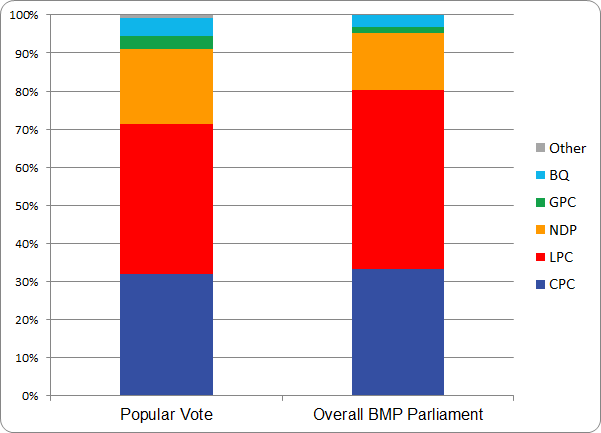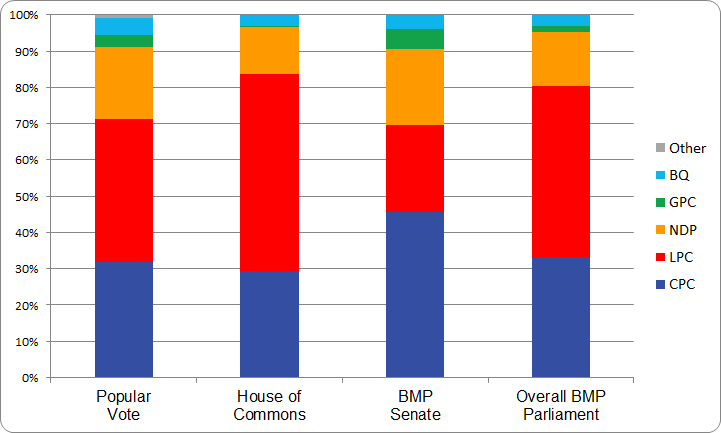The principle of the Bicameral Mixed-member Proportional (BMP) Parliament is that the Senate seats be assigned in such a way as to bring the overall proportionality of both houses closer to the popular vote. The simulations above have assumed that all Senate seats can be awarded after every election. But what about incumbent Senators?
Senators are appointed to serve until the age of 75. They may retire at any time, but are under no obligation to do so. While the implementation of BMP could put substantial public and political pressure on sitting Senators to resign, it will likely require a constitutional change to enforce it. This appendix examines how a BMP Senate might work in the presence of incumbent Senators.
As of September 2016, there are 20 vacancies and 85 sitting senators: 41 Conservative; 21 Liberal and 23 Non-Affiliated. The latter originally mostly sat within party caucuses. The intent of BMP would be defeated by ignoring incumbents as it would be unfair to award additional seats to Conservatives and Liberals when they appointed sitting Senators. Further, there would be incentive for such Senators to declare themselves Non-Affiliated in order to allow other Conservative or Liberal Senators to be appointed.
We therefore think it fairest and most consistent to treat senators by the affiliation of the Prime Minister on whose advice they were appointed.[1] On that standard, there are 49 Conservatives and 36 Liberals, distributed as shown in Table D-1.
Table D-1: Current Composition of Senate, by Affiliation of Advising Prime Minister

BMP can be implemented by retaining these incumbents, and counting them towards the respective provincial and territorial totals, filling the 20 vacancies as proportionally as possible. It can be expected that such a BMP Senate will be less proportional than if all 105 Senate seats could be awarded. In particular, Newfoundland and Labrador, Saskatchewan, Alberta and all three territories have no vacancies and so would not benefit from BMP at this time.
Simulated BMP Results for 2015 Federal Election with 20 Vacancies
A resimulation of the 2015 election results with the current senators is shown in two stages below, beginning with the distribution of the 20 vacancies.
Table D-2: 2015 Distribution of 2016 Vacant Seats in a BMP Senate

The Conservatives, with 49 incumbents, still win 2 additional Senate seats under BMP due to under-representation in Ontario. The Liberals, with 36 Incumbents and their majority in the Commons do not win any further seats. The majority of the seats go to the NDP, which reflects the mismatch between the vote and their Commons results. The final six seats are split evenly between the Greens and the Bloc Quebecois. Combining Tables D-1 and D-2 yields the BMP Senate with incumbents. The results as compared to an empty Senate are also shown, from Table A-6.
Table D-3: 2015 Distribution of Seats in a BMP Senate with Incumbents

A BMP Senate with just 20 vacancies is clearly not very proportional, yet still an obvious improvement on the current defacto two-party Senate.
Simulated BMP Results for 2015 Federal Election with 39 Vacancies
By October 2019, for the next election, there will be an additional 19 vacancies, leaving 42 Conservatives and 24 Liberals, distributed as shown in Table D-4.
Table D-4: Projected 2019 Composition of Senate, by Affiliation of Advising Prime Minister

A resimulation of the 2015 election results with the projected 2019 senators is shown in two stages below, beginning with the distribution of the projected 39 vacancies.
Table D-5: 2015 Distribution of 2019 Vacant Seats in a BMP Senate

The Conservatives, with 42 incumbents in 2019, win 6 additional Senate seats under BMP due to under-representation in several provinces. The Liberals, with 24 Incumbents in 2019 and their majority in the Commons still win one seat in Saskatchewan. Again, the majority of the seats go to the NDP, which reflects the mismatch between the vote and their Commons results. The final ten seats are split between the Greens and the Bloc. Combining Tables D-4 and D-5 yields the BMP Senate with incumbents. The results starting from an empty Senate are also shown, from Table A-6.
Table D-6: 2015 Distribution of Seats in a BMP Senate with Incumbents

A BMP Senate with 39 vacancies is still skewed by the incumbents, but is much more proportional than the current Senate. The chart below compares the proportion of the vote to that in the Commons, the Senate and the overall BMP Parliament. We can see that the overall BMP Parliament is still a better match to the Vote than the Commons (although not as close as for an empty Senate – see Figure A-2).
Figure D-1: What the Overall BMP Parliament Would Look Like (with 66 Incumbents in 2019) Compared to the 2015 Popular Vote

Figure D-2: Comparison of the Commons, Senate (with 66 Incumbents in 2019) and Overall BMP Parliament to the Popular Vote

| Overview | Appendix A | Appendix B | Appendix C | Appendix D |
End Notes
- ^ For the purposes of this exercise, senators appointed by Progressive Conservative Prime Minister Brian Mulroney are considered Conservative. Only one Senator, Nancy Ruth (Conservative), has an affiliation different from the Prime Minister who nominated her. Senator Ruth will be retire by January 2017.
